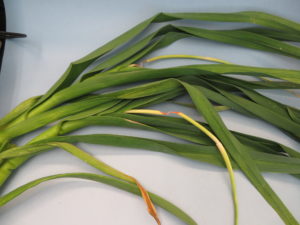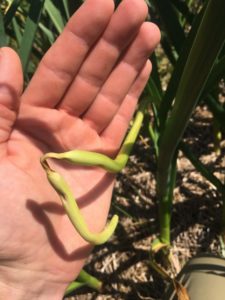Earlier this summer, sunken lesions were observed on garlic scapes on a small farm in east central Indiana. Lesions started out a cream or tan color (Figure 1), however under rainy or humid conditions, spore production caused lesions to turn orange (Figure 2). Larger lesions resulted in the collapse of the scapes. It is estimated that 45 to 50 percent of scapes were affected. Lesions ranged from ¼ to ½ inch long. Samples of these scapes were sent to the Purdue Plant and Pest Diagnostic Laboratory in West Lafayette where they were diagnosed as anthracnose of garlic, a new disease to Indiana.

Figure 1. Anthracnose of garlic, a new disease to Indiana, may cause sunken, orange lesions on scapes.
This new disease is caused by the fungus Colletotrichum fiorinae. This fungus has also been reported on elephant garlic in New York. Reports from New York suggest that onion is unaffected. In the US, C. fioriniae has also been reported as an Apple post-harvest decay, causing bitter rot on pear and anthracnose on cherry tomato.
The fungus that causes anthracnose of garlic may survive on crop residue in the soil from a previous garlic crop. If small lesions exist on bulbils used for propagation, the disease may be spread. Rainy weather may splash the spores from plant to plant.
Crop rotation that does not include garlic relatives should reduce the inoculum and thus disease severity. Bulbils used for propagation may harbor the disease. It is not clear what fungicides may be effective. However, products that are labeled and effective against Alternaria purple blight of onion may be effective against anthracnose.
Anthracnose of garlic does not seem to affect bulbs. However, scapes are sometimes removed for consumption; such yield may be reduced. The disease will negatively affect bulbil production for propagation.
